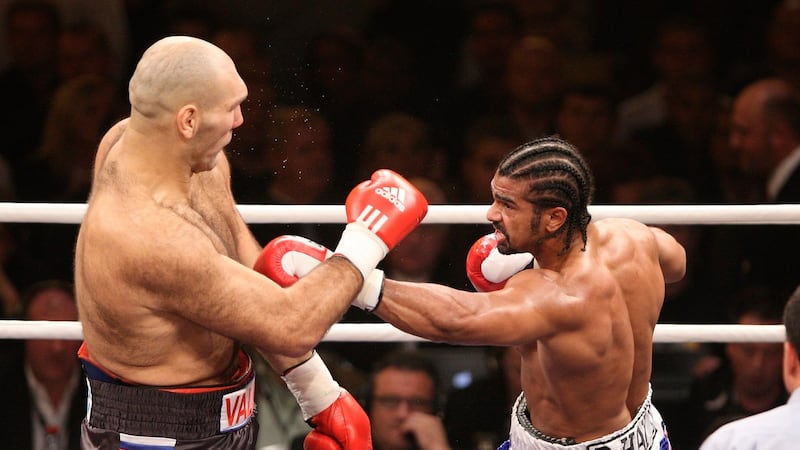David Haye has announced his retirement from boxing at the age of 37.
The former WBA heavyweight champion insisted he would stop fighting if he again lost to Tony Bellew in their rematch last month, and having shown significant signs of decline before being stopped in five rounds he has confirmed he no longer plans to fight on.
Haye first announced his retirement in October 2011 on his 31st birthday, before a lucrative grudge match with Dereck Chisora the following summer tempted him to return.
He was also advised to retire following surgery on his right shoulder in November 2013, but returned in January 2016 to secure two unremarkable victories and then suffer his third and fourth professional defeats, both against Bellew.
“Thanks to boxing, I have been able to live my unencumbered childhood dream,” Haye said in a statement.
"I became the first ever British boxer to unify the cruiserweight division. I then achieved my childhood dream when I beat WBA heavyweight champion of the world Nikolai Valuev, the 'Beast from the East', in a real life 'David and Goliath' match.
“Lifting that world heavyweight championship meant I’d fulfilled a promise I’d made to my mum, Jane, at the age of three. It also meant I was the second boxer in history — after Evander Holyfield — to win world titles at cruiserweight and heavyweight. That was an incredibly proud moment.
“In the end, what 20,000 fans inside London’s O2 Arena witnessed was me giving 100 per cent effort (against Bellew) but performing way below world level.
“For my fans, it must have been like going to support their favourite thoroughbred racehorse at the Grand National, only to see their stallion stumble out of the gates like a sedated mule at the Donkey Derby.
“I saw punches coming but wasn’t quick enough to avoid them. I created openings but lacked the speed and agility to capitalise on them. Quick counter-attacks, the sort I’ve effortlessly thrown since my teenage years, are no longer in my armoury. When I take shots, they now shake me to my boots.
“The things I used to be able to do in the ring — instinctively — now exist only in my mind and in video clips of my old fights.”
Haye made his professional debut in 2002 and despite suffering a surprise defeat to former world champion Carl Thompson in 2004, he went on to establish himself as one of the finest cruiserweights in history by travelling to Paris and climbing off the canvas to stop the dangerous Jean-Marc Mormeck in 2007, winning his first two world titles.

A third followed in March 2008 when Haye stopped Wales’ Enzo Maccarinelli, but it was after his subsequent move into the heavyweight division that he became one of Britain’s household names.
In travelling to Germany and overcoming a significant size disadvantage to defeat Valuev and claim the WBA title in November 2009, Haye enjoyed perhaps his greatest night.
His speed, power, head movement and footwork inspired his success as he succeeded Ricky Hatton as British boxing's biggest draw, and to the extent that his then-trainer Adam Booth developed a reputation he retains as one of the finest in the world.
Successful title defences followed against John Ruiz and Audley Harrison before in July 2011 he was outpointed by Wladimir Klitschko for the WBA, WBO and IBF titles, in what was then the highest-profile heavyweight fight since Lennox Lewis' victory over Mike Tyson in 2002.
He was widely criticised for blaming defeat on a broken little toe, as he also was when he brawled with Chisora at a press conference the following year, before he then became the first to stop his rival in a fight that was not sanctioned by the British Boxing Board of Control.
If that had represented the perfect time to permanently retire, Haye then attempted to return against Manuel Charr and twice against Tyson Fury but those fights were derailed by hand, eye and shoulder problems.
“Often it was a fight just getting to the ring in one piece,” he added, referring to this period of his career.
“In the past five years I have snapped both biceps, my rotator cuff and my Achilles tendon. All four injuries were potentially career-ending and each of them required operations with months of intense rehabilitation.
“The biggest physical challenge I had to face, however, was spinal surgery in March 2015. I herniated a disc in my lower back 10 years ago and years of intense training wore this disc away, resulting in chronic pain and loss of function in both legs. An operation was required to put a two-centimetre metal cage between two vertebrae and implant two metal rods with screws and bone grafts to fuse it all together.”
When he finally fought again in 2016 — without Booth as his trainer — and defeated the little-known Mark de Mori and Arnold Gjergjaj, Haye was far heavier than at his peak and had lost the speed that had brought him such success.
The first of his two defeats to Bellew followed when the by now injury-prone heavyweight ruptured his Achilles mid-fight. In their rematch last month, it was again clear that he was physically not the same, ultimately leaving him with few options but to finally end a very good career.















